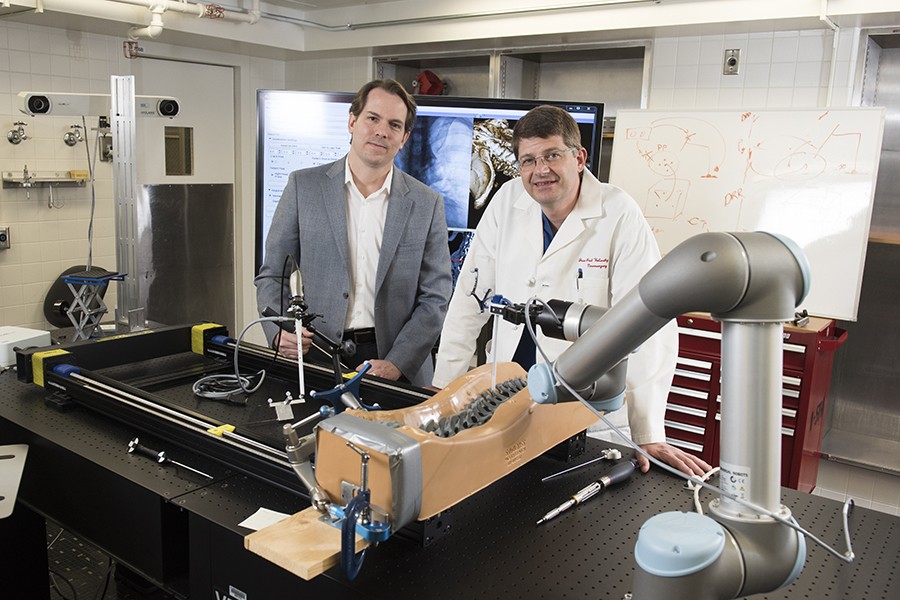On the seventh floor of the Johns Hopkins Hospital's Carnegie Building, in what once was a postoperative recovery room, biomedical engineering students are designing biomedical tools, algorithms, and imaging systems that could shape the future of surgery. Not far from their workstations, toolboxes, and robots, a foosball table provides a place for researchers and clinicians to unwind. Nearby, a giant TV screen is on 24/7, linking the Carnegie Center to the BME Design Studio in Clark Hall on Johns Hopkins University's Homewood campus.
For Jeff Siewerdsen, a professor of biomedical engineering, it was not hard to imagine such a synergistic connection between biomedical engineers and surgeons.
"Clinical collaboration has always been the inspiration for our research," says Siewerdsen, who collaborated with neurosurgery Professor Jean-Paul Wolinsky to create the center. "What's extraordinary is seeing that connection come to life in the same vintage operating rooms where so many landmark surgical procedures of the 20th century were pioneered."
The Carnegie Center for Surgical Innovation presents a unique resource for research, education, and translation that the departments of Neurosurgery and Biomedical Engineering hope will transform surgery, imaging science, and other disciplines in the 21st century.
Siewerdsen and Wolinsky's vision for the new laboratory began to take shape four years ago, when Johns Hopkins Hospital's main operating rooms were moved from Carnegie, which was built in 1927, to the new Zayed and Bloomberg clinical towers. Siewerdsen and Wolinsky proposed increasing collaborations between their departments by converting some of the vacated space into a joint neurosurgery and biomedical engineering education and research center. Fueled by National Institutes of Health-funded research, this hospital-based joint neurosurgery and biomedical engineering lab is unique in North America.
It is also singular in how it showcases elements of its storied past. In the post-anesthesia care room, where patients were taken immediately after surgery—and where today's research students now focus on screens scrolling with code, equations, and 3-D images—20 patient monitoring panels still line the walls. Into these were plugged a variety of post-op devices—from electrocardiograms to oxygen hookups and vacuum suctioning equipment.
Siewerdsen, who holds appointments in BME, Neurosurgery, Oncology, Computer Science, Radiology, and the Armstrong Institute for Patient Safety and Quality, focuses his research on the creation of new imaging systems to improve surgical precision, enhance patient safety, and enable entirely new surgical approaches. In addition to directing the Carnegie Center, he heads the I-STAR Lab—a collaboration focusing on new systems for X-ray imaging and cone-beam CT, image registration, and 3-D image reconstruction for surgery, radiotherapy, and diagnostic radiology.
In coming months, several other biomedical engineering faculty will bring new research expertise to the Carnegie Center, including: Xingde Li, who leads a program in biophotonics; Muyinatu A. Lediju Bell, assistant professor of electrical and computer engineering, who focuses on ultrasound imaging; and Wojciech Zbijewski, a researcher who focuses on high-resolution imaging of bone health.
For students on the Homewood campus, such as candidates from the master's program at the Center for Bioengineering Innovation and Design, the Carnegie Center provides an invaluable new resource for student collaboration with clinicians.
"The surgeons are right outside the door," Siewerdsen says, "and colocation in Carnegie helps break down conventional geographic barriers, give students better understanding of clinical problems, catalyze new ideas, and provide a proving ground for clinical translation."
Adapted from an article by Neil A. Grauer for Johns Hopkins Medicine's Dome.
Posted in Health, Science+Technology
Tagged biomedical engineering, cbid








